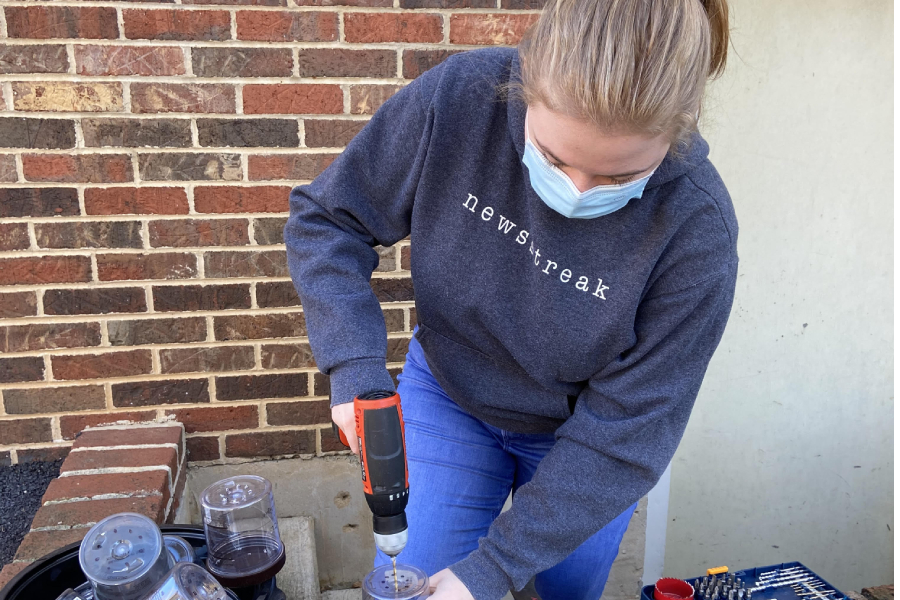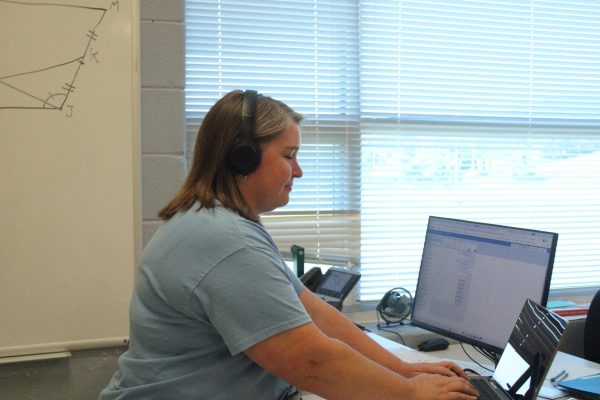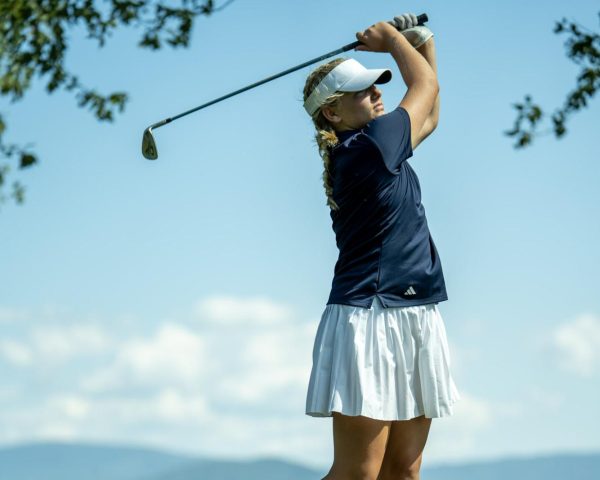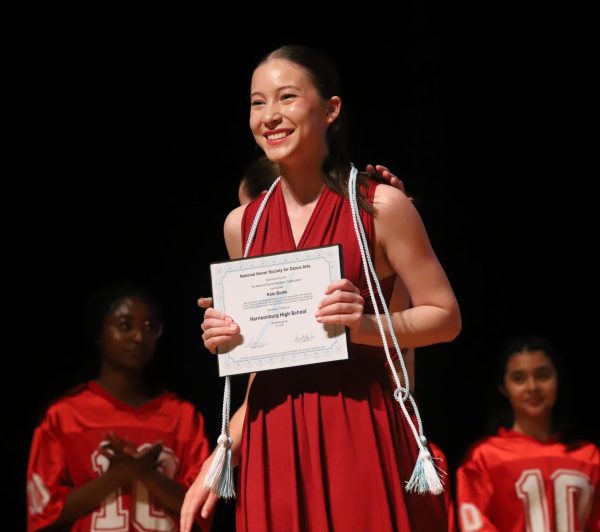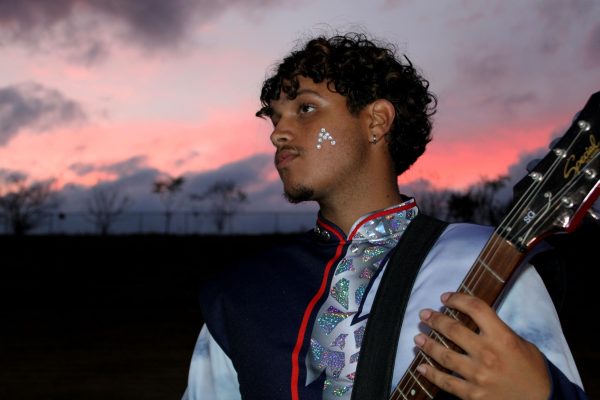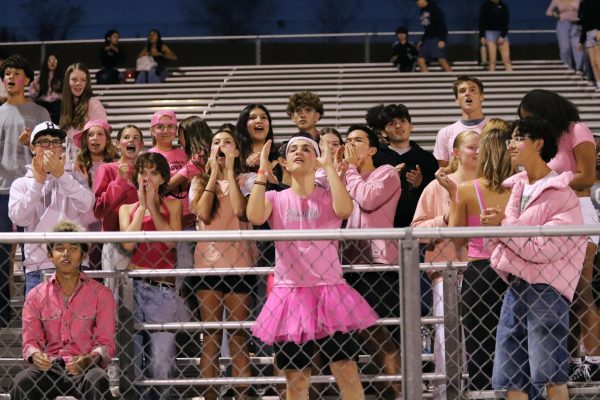Upperclassmen create engineering projects, attend virtual science fair
Photo Used With Permission From Betsy Quimby
Senior Betsy Quimby drills to work on her vertical farm engineering project. Quimby and her partner, senior Mia Constantin, entered this farm in the Shenandoah Valley Regional Science and Engineering Fair, and the pair won a bronze medal.
The Shenandoah Valley Regional Science and Engineering Fair had their 62nd Annual Fair on Tuesday, March 23. One of the participants of this science fair was junior Owen Johnston. Johnston participated in his first science fair this year, and he plans to attend another science fair next year.
“[This was my first time in the science fair] pretty much. I intend to do it next year as well,” Johnston said.
Due to COVID this year, the science fair was virtual to ensure the safety of the participants and the staff.
“We got on a Zoom meeting and presented our screen, [then] we did a short 10 minute presentation on our project,” Johnston said.
Johnston didn’t really have a reason or desire to join the science fair.
“I don’t really have a specific reason why I did it. I thought it would be a fun experience to do one,” Johnston said.
Johnston worked on customizing a bicycle by adding two wheels to help someone who has trouble balancing.
“This year, I worked on creating, adapting and modifying an existing bicycle that had two front wheels. We worked on creating that to help someone who struggled with balancing a regular bicycle,” Johnston said.
There was a process to creating Johnston’s project. He first had to get some information and knowledge from a professional, then pave the way for his design.
“I reached out to a local bike shop, and they helped me with the mechanical machining, stuff like that. We started off by sketching out the kind of design we wanted. Then we put that plan into action and cut the tubes and then braised them together to create a functioning bike,” Johnston said.
Johnston got his idea after he heard that a community member was struggling to balance on a bike. This is what influenced his idea the most.
“I had heard of our community member who was struggling to balance from the shop owner, and we originally thought of doing a recumbent bicycle. But we realized that [we had] limited ability to decide to modify that design [and] move it into a regular bicycle form but with just the two wheels in the front. We hope that would allow him to, you know, easily balance,” Johnston said.
Johnston did face obstacles in creating his project, as he had to redesign his project due to small mistakes.
“In the end, we’ve realized that we had designed the two front wheels to be a little bit too small or too close together, so it didn’t provide as much stability as we had hoped for. So eventually we made a wider wheelbase or one for a wider wheelbase,” Johnston said.
To overcome this, Johnston had to brainstorm ideas to remedy his problem.
“Well, we usually take a step back [and think about what] went on or what is stopping us, and then try to find a solution on how to fix that if it’s possible,” Johnston said.
In the science fair, there were awards and prizes given to the participants.
“So I won that SAE Patient and Mobility Award, which is an automotive club, but it’s in engineering [and] works with automobiles and innovations in mobility.” Johnston said.
Johnston enjoyed his experience in the science fair, but he missed out on the in-person aspect of interacting with other participants.
“I haven’t experienced the in-person part, but from what I experienced with the virtual is, it was a good experience,” Johnston said.
Seniors Elizabeth Quimby and Mia Constantin were also participants of the science fair, and both were partners in their project. Like Johnston, it was the first science fair they’ve experienced.
“We’ve both never done it before,” Constantin said.
Both Quimby and Constantin were inspired to join the science fair, as Quimby was inspired by her partner Constantin and gained the feeling of motivation from her.
“If I was doing it alone, I wouldn’t have done it because I didn’t really care that much, but my partner inspired me to keep going with the project,” Quimby said.
Constantin was inspired by her mother who works as a physics professor in James Madison University. Her mother has taken Constantin to almost all of her meetings and conferences, which, according to Constantin, are like bigger science fairs.
“My mom is a physics professor at JMU, and she does a lot of research. She has also taken me along to almost all of her conferences, which are just bigger science fairs, and she’s presented posters and presentations there. It always seemed like something cool, and she encouraged me to get some research experience before college,” Constantin said.
Both partners also had a reason and goal to join the science fair, which was for academic purposes.
“So we started the project in our DE engineering class, and it’s like a capstone project for our big senior year project, and we had the option to enter it in the science fair and my partner and I thought that it was a really cool project, so we decided to enter it in there because we could win some awards or scholarships,” Quimby said.
Constantin also had the same reason for joining the fair.
“I was in the Dual Enrollment Engineering class to fill out my capstone requirement for the Governor’s STEM Academy, and my teacher, Mr. Jackson, had come up with the idea for our class to do a yearlong research project,” Constantin said.
Quimby and Constantin designed and built a vertical garden for their project.
“Betsy and I created a small scale vertical farm. A vertical farm is a practice that stacks plants vertically in a controlled environment, typically soilless, using different techniques such as aquaponics, hydroponics and aeroponics. These methods can conserve water [and] natural resources, and [they can] produce 10 acres of food on 1/10th of an acre of land,” Constantin said.
One big goal that Quimby and Constantin aimed for when creating this project would be that it would help people with less access to food such as the homeless and low-income families.
“Our goal was to try and make it very sustainable and eco-friendly to build and also be able to produce fresh food for low income families in our area,” Quimby said.
Quimby and Constantin followed a certain process to creating the project.
“We first started with a prototype to make sure our design worked. Our prototype didn’t have a vertical element to it, but it helped us modify the design of our planters. After our prototype worked, we built the wooden frame for our farm, and then worked on constructing our planters out of recycled yogurt and ice cream cups,” Constantin said.
Both partners faced certain obstacles while creating their project.
“There was the obstacle of having COVID involved and making sure that we were safe when we met up. It would just always involve me driving over to her house. So if the weather was bad or something, maybe I couldn’t go. So of course it was just the obstacle of not being able to meet up every day like [if] you went to class,” Quimby said.
However, not being able to meet up in-person or communicate efficiently at times wasn’t the only obstacles they had to face.
“One obstacle that we faced was the fact that we built our farm over the winter, which stopped us two times. Once when we tried to find seeds to grow plants with, we had to drive to Staunton to find them, and another time when our seeds wouldn’t grow due to the cold and lack of sunlight,” Constantin said.
Some of the crops that they grew included cabbages, radishes and mustard greens. At the end, Constantin and Quimby ended up winning the bronze distinction award in their category.
“My partner and I won a bronze distinction in our category of environmental science,” Constantin said.
For both partners, the hardest part of the science fair was building a good presentation as well as practicing the presentation.
“The hardest part of the science fair for Betsy and I was practicing our presentation and making sure we got all of the information we needed in our designated time slot,” Constantin said.
Quimby agreed with Constantin that the presentation was the most difficult part of the science fair.
“I think the hardest part was coordinating with my partner [for] our presentation because I think our project was really strong, but we needed to make a presentation that would be able to tell exactly what we did in a good way. So we had to do a lot of practice making our presentation and going over it,” Quimby said.
Both partners enjoyed talking about their project and reading their presentation the most.
“It was cool because the [judges] had really good questions about it, and it was fun to talk about it,” Quimby said.
Constantin also says the same.
“The most exciting part was giving the presentation and doing really well,” Constantin said.
Your donation will support the student journalists of Harrisonburg High School. Your contribution will allow us to purchase equipment and cover our annual website hosting costs.



